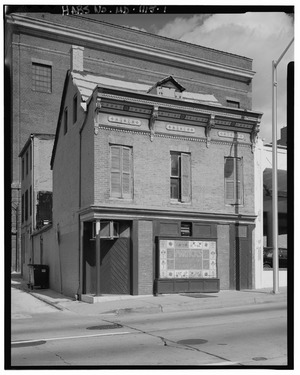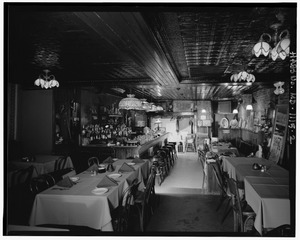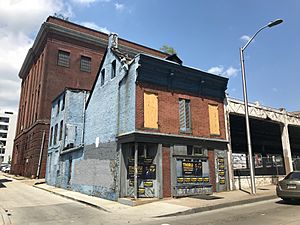Martick's Restaurant Francais facts for kids
Quick facts for kids Martick's Restaurant Francais |
|
|---|---|

Martick's Restaurant Francais, prior to closure
|
|
| Lua error in Module:Location_map at line 420: attempt to index field 'wikibase' (a nil value). | |
| Restaurant information | |
| Established | 1970 |
| Closed | 2008 |
| Previous owner(s) | Morris Martick |
| Chef | Morris Martick |
| Food type | French cuisine |
| Street address | 214 West Mulberry St |
| City | Baltimore |
| State | Maryland |
| Coordinates | 39°17′38.75″N 76°37′08.10″W / 39.2940972°N 76.6189167°W |
Martick's Restaurant Francais was a famous restaurant and historic building in Downtown Baltimore, Maryland. The building was built around 1852 in the Federal style, which means it had a simple, balanced design.
Over the years, the building was used for many different things. On July 9, 1970, it opened as a French restaurant. Martick's was known as a special place for artists. It was seen as a "tiny island of Bohemia" in a more traditional city. This means it was a place where creative and free-spirited people felt at home.
The building is in Baltimore's Bromo Arts District. It is also part of the Market Center district, which is listed on the National Register of Historic Places. Martick's was important in showing why the Howard Street district should be protected. A report in 2018 called Martick's "the only remaining sign of the street's historic look."
Contents
A Building with a Long Story
The building at 214 West Mulberry Street is a rowhouse, built between the 1830s and 1850s. Around 1900, it became a store. In 1917, Harry and Florence Martick, who were Jewish immigrants from Poland, bought it as a grocery store.
During Prohibition (when alcohol was illegal), the Marticks ran a secret bar called a speakeasy from their store. Harry Martick faced legal trouble for this. After Prohibition ended in 1933, the Marticks got a license to sell drinks. They turned their grocery store into a corner bar, sometimes called the Mahogany Tavern.
Martick's Lower Tyson Street Tavern: A Creative Hub
In the late 1940s, Morris Martick, Harry and Florence's son, took over the bar. He renamed it Martick's Tyson Street Tavern or Martick's Lower Tyson Street Tavern. Morris made the bar more than just a place for drinks. He hosted silent movie nights, chess games, and live jazz music.
Morris also opened an art gallery nearby. He let artists show their work in the bar itself, which was very new at the time. This helped new artists like Joan Erbe get noticed.
By the 1950s, Martick's was known as a place where thinkers and artists met. Famous people like Leonard Bernstein would play the bar's piano. Even Billie Holiday sang with the jazz band there. Hank Williams also played at Martick's.
The bar was welcoming to all people, including those who were gay, which was rare back then. It was also one of the first bars in Baltimore to be integrated. This means people of all races were welcome, even when segregation was still common. Morris Martick said he "served anyone who came in [and] didn't worry about their race."
Many different kinds of people visited the bar. These included writers, artists, and even future film director John Waters. Waters and his friends, who later became known as the Dreamlanders, found Martick's to be an important place for their art. Waters met many of his future movie collaborators there, like Pat Moran and George Figgs. Maelcum Soul, another artist who worked with Waters, was a bartender at Martick's.
By the mid-1960s, Morris Martick closed the Tavern. The building at 214 West Mulberry Street was the last original rowhouse left on its block.
Martick's Restaurant Francais: A New Chapter
After closing the bar, Morris Martick went to France to learn about French cooking. On July 9, 1970, after two years of work, he opened the new Martick's Restaurant Francais. It was said to be the first French restaurant in Baltimore.
At first, the restaurant tried to be very fancy, with waiters in tuxedos. But soon, Morris Martick himself became the chef. The restaurant became known for its unique and artistic decorations. Morris Martick decorated it with things like snakeskin wallpaper, stained glass, and even bowling balls.
John Waters continued to visit the restaurant often. Because of its unique style and famous visitors, Martick's became known as one of Baltimore's "quirkier restaurants." Morris Martick and his restaurant became famous for dishes like pâté (a type of spread), profiteroles (cream puffs), and bouillabaisse (a fish stew).
In the 1970s, the front window and entrance were boarded up for safety reasons. The building was later listed in city plans for urban renewal. However, then-Mayor Martin O'Malley worked to protect many historic buildings, including Martick's.
Closure and Lasting Impact
Morris Martick closed the restaurant in late 2008. At the time, the building had some problems with its condition. Morris Martick lived in the building until he passed away on December 16, 2011. His family then took ownership of the building.
Even after it closed, Martick's is still remembered as one of Baltimore's "iconic eateries." Many articles have described the building and restaurant as a "hub of city artistic life" and "utterly unlike anywhere else." It truly left a mark on Baltimore's history and art scene.
Future Plans for the Building
After Martick's closed, there were several ideas to bring the building back to life. In 2012, Morris Martick's brother, Alex Martick, planned to open a new bar called Martick's. However, these plans did not work out. Other plans for revival also came and went over the years.
In 2018, a developer bought the building. They first thought about tearing it down. But after learning about its history, they decided to try to save it. Their new plan was to have a restaurant downstairs and art studios upstairs. However, these plans also changed, and the building was sold again in late 2018.
A new group, Park Avenue Partners, then proposed to build a six-story apartment building with shops. They wanted to include the historic Martick's building in their plans. However, they later asked to tear it down, saying it was too damaged.
The city's historical committee, CHAP, looked at the building's importance. They said it was important for Baltimore's business history, its connection to Morris Martick, and its unique architecture. CHAP suggested that the developer try to keep at least part of the building.
In early 2019, the developer offered a new plan. They would restore and keep the front part of the Martick's building, which is the oldest part. They would tear down the back part. The committee approved this plan. This way, a piece of Martick's history will be saved for the future.



